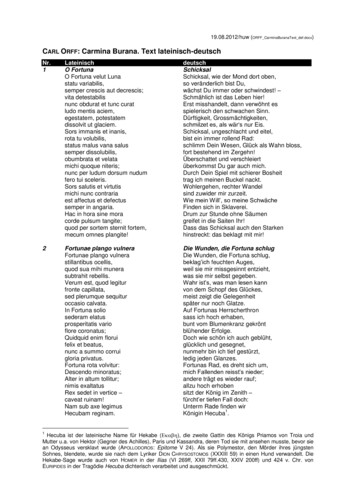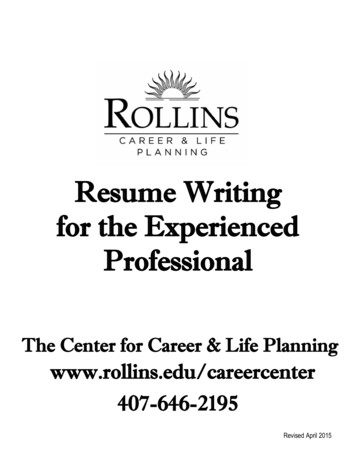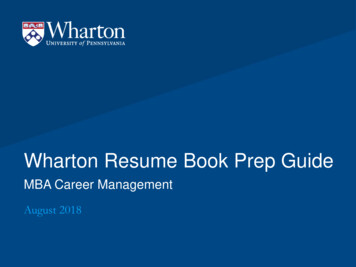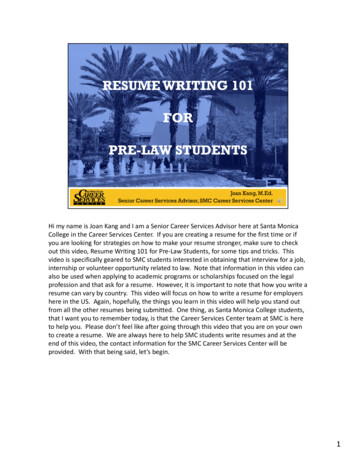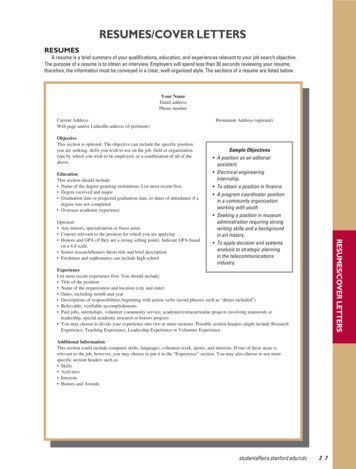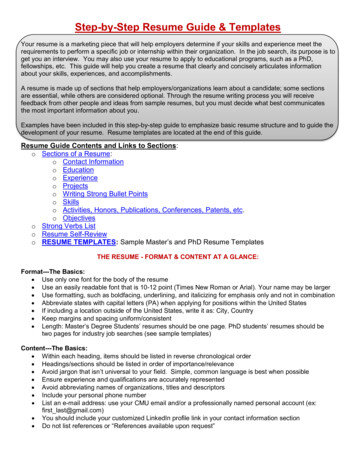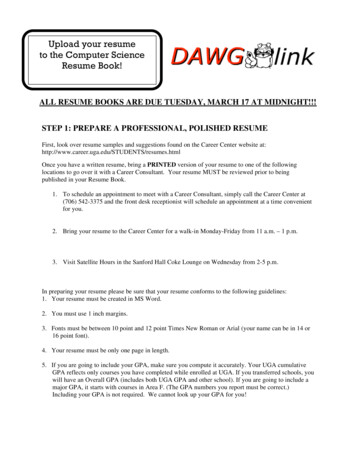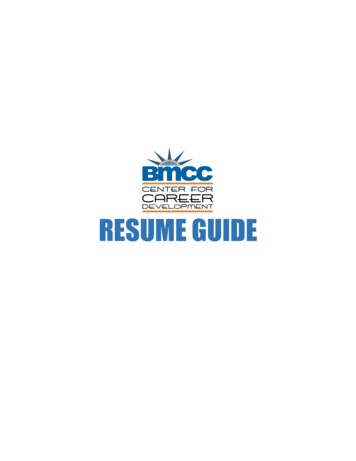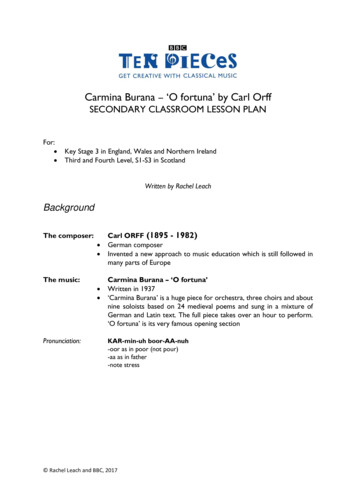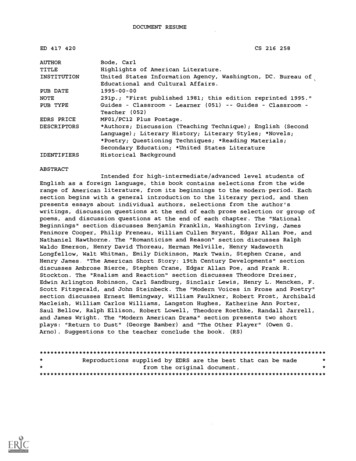
Transcription
DOCUMENT RESUMEED 417 420AUTHORTITLEINSTITUTIONPUB DATENOTEPUB TYPEEDRS PRICEDESCRIPTORSIDENTIFIERSCS 216 258Bode, CarlHighlights of American Literature.United States Information Agency, Washington, DC. Bureau ofEducational and Cultural Affairs.1995-00-00291p.; "First published 1981; this edition reprinted 1995."Guides - ClassroomLearner (051)GuidesClassroomTeacher (052)MF01/PC12 Plus Postage.*Authors; Discussion (Teaching Technique); English (SecondLanguage); Literary History; Literary Styles; *Novels;*Poetry; Questioning Techniques; *Reading Materials;Secondary Education; *United States LiteratureHistorical BackgroundABSTRACTIntended for high-intermediate/advanced level students ofEnglish as a foreign language, this book contains selections from the widerange of American literature, from its beginnings to the modern period. Eachsection begins with a general introduction to the literary period, and thenpresents essays about individual authors, selections from the author'swritings, discussion questions at the end of each prose selection or group ofpoems, and discussion questions at the end of each chapter. The "NationalBeginnings" section discusses Benjamin Franklin, Washington Irving, JamesFenimore Cooper, Philip Freneau, William Cullen Bryant, Edgar Allan Poe, andNathaniel Hawthorne. The "Romanticism and Reason" section discusses RalphWaldo Emerson, Henry David Thoreau, Herman Melville, Henry WadsworthLongfellow, Walt Whitman, Emily Dickinson, Mark Twain, Stephen Crane, andHenry James, "The American Short Story: 19th Century Developments" sectiondiscusses Ambrose Bierce, Stephen Crane, Edgar Allan Poe, and Frank R.Stockton. The "Realism and Reaction" section discusses Theodore Dreiser,Edwin Arlington Robinson, Carl Sandburg, Sinclair Lewis, Henry L. Mencken, F.Scott Fitzgerald, and John Steinbeck. The "Modern Voices in Prose and Poetry"section discusses Ernest Hemingway, William Faulkner, Robert Frost, ArchibaldMacleish, William Carlos Williams, Langston Hughes, Katherine Ann Porter,Saul Bellow, Ralph Ellison, Robert Lowell, Theodore Roethke, Randall Jarrell,and James Wright. The "Modern American Drama" section presents two shortplays: "Return to Dust" (George Bamber) and "The Other Player" (Owen G.Arno). Suggestions to the teacher conclude the book. ************************************Reproductions supplied by EDRS are the best that can be made**from the original ***************************************
0U S DEPARTMENT OF EDUCATIONOffice of Educational Research and ImprovementEDUCATIONAL RESOURCES INFORMATIONCENTER (ERIC)This document has been reproduced asreceived from the person or organizationoriginating itMinor changes have been made toimprove reproduction qualityPoints of view or opinions stated in thisdocument do not necessarily representofficial OERI position or policyIII Ia a.a11111111111111411411h.114E MMMMMMMMMMMMMMMMMM k a IN a 119illiabillaaaaaeNOWNMMMMMal NI SI IN IIAvLJet. 4111 as.MMMMMMMM **algaMMMMMM M: wellID MSisasOOOOOOOOOOOO it1OOOOOOOOOIN II411114alia811ksIN III OOOOOIIOOOOOO ToMIa11144,1011411 ra., V 141P9I1HIGHLIGHTL1312LFLii
Dean Curry, General Series EditorHIGHLIGHTSOFAMERICANLITERATUREBased upon a core manuscript byDr. Carl Bode, University of MarylandEnglish Language Programs DivisionBureau of Educational and Cultural AffairsUnited States Information AgencyWashington, D.C. 205473
Highlights of American LiteraturePublished by the Materials BranchEnglish Language Programs DivisionU.S. Information AgencyWashington, D. C. 20547First published 1981. This edition reprinted 1995.Cover Photo: A view of Chicago skyscrapersfrom the 110th floor of the Sears Tower.Source: USIA4
CONTENTSPageNational BeginningsIntroductionChapter IChapter IIChapter HIChapter IVChapter VChapter VIChapter VII5Benjamin Franklin (1706-1790)Washington Irving (1783-1859)James Fenimore Cooper (1789-1851)Philip Freneau (1752-1832)William Cullen Bryant (1794-1878)Edgar Allan Poe (1809-1849)Nathaniel Hawthorne (1804-1864)10162229333944Romanticism and ReasonIntroductionChapter VIIIChapter IXChapter XChapter XIChapter XIIChapter XIIIChapter XIVChapter XVChapter XVI52Ralph Waldo Emerson (1803-1882)Henry David Thoreau (1817-1862)Herman Melville (1819-1891)Henry Wadsworth Longfellow (1807-1882)Walt Whitman (1819-1892)Emily Dickinson (1830-1886)Mark Twain (1835-1910)Stephen Crane (1871-1900)Henry James (1843-1916)57647177829097104112The American Short Story: 19th Century DevelopmentsIntroductionChapter XVIIChapter XVIIIChapter XIXChapter XX119Ambrose Bierce (1842-1914?)Stephen Crane (1871-1900)Edgar Allan Poe (1809-1849)Frank R. Stockton (1834-1902)120127135140Realism and ReactionIntroductionChapter XXIChapter XXIIChapter XXIIIChapter XXIV145Theodore Dreiser (1871-1945)Edwin Arlington Robinson (1869-1935)Carl Sandburg (1878-1967)Sinclair Lewis (1885-1951)J150156163169
Chapter XXVChapter XXVIChapter XXVIIHenry L. Mencken (1880-1956)F. Scott Fitzgerald (1896-1940)John Steinbeck (1902-1968)175181185Modern Voices in Prose and PoetryIntroductionChapter XXVIIIChapter XXIXChapter XXXChapter XXXIChapter XXXIIChapter XXXIIIChapter XXXIVChapter XXXV196Ernest HemingwayWilliam FaulknerRobert FrostArchibald MacLeish, William Carlos Williams andLangston HughesKatherine Ann PorterSaul BellowRalph EllisonRobert Lowell, Theodore Roethke, Randall Jarrelland James Wright201207214221231238244249Modern American DramaIntroductionChapter XXXVIChapter XXXVII261Return to DustThe Other Player262270Suggestions to the Teacher282Acknowledgments287
NATIONAL BEGINNINGShope of perfect recovery shortly, even by thevery wholesomeness of the air.The first American literature was neitherAmerican nor really literature. It wasnot American because it was the work mainlyof immigrants from England. It was notPoor Higginson did not fare as well as hisson; he died the same year theNew-England's Plantation was published.Other writers echoed the descriptions andexaggerations of Smith and Higginson. Theirpurpose was to attract dissatisfied inhabitantsof the Old World across the ocean to the New.As a result, their travel accounts became akind of literature to which many groupsresponded by making the hazardous crossingto America. The earliest settlers includedDutch, Swedes, Germans, French, Spaniards,Italians, and Portuguese. Of the immigrantswho came to America in the first threequarters of the seventeenth century, however,the overwhelming majority was English.The English immigrants who settled onAmerica's northern seacoast, appropriatelycalled New England, came in order topractice their religion freely. They were eitherEnglishmen who wanted to reform the Churchof England or people who wanted to have anentirely new church. These two groupscombined, especially in what becameMassachusetts, came to be known as"Puritans," so named after those who wishedto "purify" the Church of England.The Puritans followed many of the ideas ofthe Swiss reformer John Calvin. Through theCalvinist influence the Puritans emphasizedthe then common belief that human beingswere basically evil and could do nothingabout it; and that many of them, though notall, would surely be condemned to hell,Over the years the Puritans built a way oflife that was in harmony with their somberreligion, one that stressed hard work, thrift,piety, and sobriety. These were the Puritanvalues that dominated much of the earliestAmerican writing, including the sermons,books, and letters of such noted Puritanclergymen as John Cotton and Cotton Mather.During his life Cotton Mather wrote more than450 works, an impressive output of religiouswritings that demonstrates that he was anexample, as well as an advocate, of thePuritan ideal of hard work.literature as we know itin the form of poetry,essays, or fictionbut rather an interestingmixture of travel accounts and religiouswritings.The earliest colonial travel accounts arerecords of the perils and frustrations thatchallenged the courage of America's firstsettlers. William Bradford's History ofPlimmoth Plantation describes the coldgreeting which the passengers on the shipMayflower received when they landed on thecoast of America in 1620:Being thus arrived in a good harbor, andbrought safe to land, they fell upon theirknees and blessed the God of Heaven whohad brought them over the vast and furiousocean, and delivered them from the perils andmiseries thereof, again to set their feet on thefirm and stable earth, their proper element.But here I cannot stand half amazed at thispoor people's present condition; and so Ithink will the reader, too, when he wellconsiders the same. Being thus passed thevast ocean, . they had no friends towelcome them nor Inns to entertain or refreshtheir weatherbeaten bodies; nor houses ormuch less towns to repair to, to seek forsuccour.If the American wilderness did not providea hearty welcome for the colonists, itnevertheless offered a wealth of naturalresources. "He is a bad fisher [who] cannotkill on one day with his hooke and line, one,two, or three hundred Cods" is a claim madeby Captain John Smith in A Description ofNew England (1616). "A sup of NewEngland's air is better than a whole draft ofold England's ale" is a testimonial given byFrancis Higginson in his New-England'sPlantation (1630). Higginson adds:Besides, I have one of my children that wasformerly most lamentably handled with sorebreaking out of both his hands and feet of theking's evil, but since he came hither heis very well over [what] he was, and there is57
HIGHLIGHTS OF AMERICAN LITERATUREDuring the last half of the seventeenthcentury the Atlantic coast was settled boththe day when God will decide the fate of man.Most people will be sent to Hell; a few luckyones will be chosen to go to Heaven.According to Wigglesworth, the start of thisfinal day will be signaled by a bright light atmidnight which will wake all the sinners:north and south. Coloniesstill largelyEnglishwere established. Among thecolonists could be found poets and essayists,but no novelists. The absence of novelists isquite understandable: the novel form had noteven developed fully in England; the Puritanmembers of the colonies believed that fictionought not to be read because it was, bydefinition, not true.The American poets who emerged in theseventeenth century adapted the style ofestablished European poets to the subjectmatter confronted in a strange, newenvironment. Anne Bradstreet was one suchThey rush from beds with giddy heads,and to their windows run,Viewing this light which shone more brightthan doth the noonday sun.Many people will try in vain to escape theirfinal judgment:Some hide themselves in caves and delves,in places underground:Some rashly leap into the deep,to escape by being drowned:Some to the rocks (0 senseless blocks!)and woody mountains run.That there they might this fearful sight,and dreaded presence shun.poet.Born and educated in England, AnneBradstreet both admired and imitated severalEnglish poets. The influence of these Englishpoets did not diminish when Mrs. Bradstreet, atage eighteen, came to America in 1630. Theenvironment in which she wrote, however, didnot remain constant; a developed nation wasexchanged for a relative wilderness. Thatthis exchange brought its hardships is evidentin these lines from Bradstreet's Some Verseson the Burning of Our House":Wigglesworth concludes that escape will beimpossible. Inevitably, man must and willaccept his fate on "The Day of Doom."In the colonies south of Wigglesworth's NewEngland, less gloomy poets and essayistswrote. But the southern colonies did not havethe printing facilities found in New England,and no poet elsewhere achieved thepopularity of Michael Wigglesworth.Twentieth century literary scholars havediscovered the manuscripts of a contemporaryof Wigglesworth named Edward Taylor whoproduced what is perhaps the finestseventeenth century American verse. Writingmuch of his poetry as a mental exerciseorWhen by the ruins oft I pastMy sorrowing eyes aside did cast,And here and there the places spyWhere oft I and long did lie:Here stood that trunk, and there that chest,There lay that store I counted best.My pleasant things in ashes lie,And them behold no more shall I.Mrs. Bradstreet lessens this despair byasserting that earthly possessions are no morethan "dunghill mists" when compared to the"richly furnished" house of Heaven. In herrejection of wordly riches, Anne Bradstreetshared a common outlook with her NewEngland neighbors. Her ability to capture thecolonial experience in poetry established herplace as one of America's most notable earlywriters.Michael Wigglesworth, another importantcolonial poet, achieved wide popularityamong his contemporaries with his gloomypoem entitled "The Day of Doom." Firstpublished in 1662, "The Day of Doom" is adescription of the day of judgment. It tells of8"Meditation"to prepare him for his duties asa minister, Taylor filled his works with vividimagery. Here, for example, are Taylor'sdescriptions of the unworthy heart of man:A sty of filth, a trough of washing swill,A dunghill pit, a puddle of mere slime.A nest of vipers, hive of hornet's stings,A bag of poison, civet box of sins.Taylor never published any of his poetry. Infact, the first of Edward Taylor's colonialpoetry did not reach print until the thirddecade of the twentieth century.Taylor, like many of the early colonialwriters, was an immigrant whose writing was6
influenced by his early experiencies inEngland. As the decades passed newgenerations of American-born writers becameimportant. Boston, Massachusetts, was thebirthplace of one such American-born writer.His name was Benjamin Franklin.Benjamin Franklin was a brilliant,industrious, and versatile man. Starting as apoor boy in a family of seventeen children, hebecame famous on both sides of the Atlanticas a statesman, scientist, and author. Despitehis fame, however, he always remained a manof industry and simple tastes.Franklin's writings range from informalsermons on thrift to urbane essays. He wrotegracefully as well as clearly, with a wit whichoften gave an edge to his words. Though thestyle he formed came from imitating two notedEnglish essayists, Addison and Steele, hemade it into his own. His most famous work ishis Autobiography.Franklin's Autobiography is many things.First of all it is an inspiring account of a poorboy's rise to a high position. Franklin tells hisstory modestly, omitting some of the honorshe received and including mention of some ofhis misdeeds, his errors as he called them.He is not afraid to show himself as beingmuch less than perfect, and he is resigned tothe fact that his misdeeds will often receive apunishment of one sort or another. Viewinghimself with objectivity, Franklin offers his lifestory as a lesson to others. It is a positivelesson that teaches the reader to live a usefullife. In fact, the Autobiography is ahow-to-do-it book, a book on the art ofself-improvement.The practical world of Benjamin Franklinstands in sharp contrast to the fantasy worldcreated by Washington Irving. Named afterGeorge Washington, the first president of theUnited States, Irving provided a young nationwith humorous, fictional accounts of thecolonial past. Many of Irving's other writingstake the reader to foreign lands, especially toSpain at the time of the Moors. But his tales ofcolonial America remain his most enduringcontributions to American and world literature.The Dutch culture in colonial New York wasof particular interest to Irving. He published amockserious history of the New York ofcolonial times which shows his sly humor andgeneral good nature. This same geographicarea provides the background for Irving's bestknown work, the short story "Rip Van Winkle.""Rip Van Winkle" is a humorous tale of alazy villager in the mountains of upstate NewYork. While hunting, Rip meets somemischievous Dutch gnomes. He drinks withthem, and through the power of the drink fallsasleep for twenty years. On awakening hemakes his unsteady way back to his village.Rip finds the village greatly changed. Whenhe went to sleep it was still under British rule.Now it is a part of the United States, the newnation formed as a result of the RevolutionaryWar. Though he is confused by the changesthat have come with democracy, he gets usedto them. By the end of the story he is back atthe village tavern, drinking and ready to tellany stranger about his remarkable slumber.Through "Rip Van Winkle" and several otherstories Irving helped to create what might becalled an American mythology. Thismythology is made up of stories of theAmerican past so widely read and told thatnearly every American recognizes them.Another writer, James Fenimore Cooper,contributed two of the great stock figures ofAmerican mythology: the daring frontiersmanand the bold Indian. Cooper's exciting storiesof the American frontier have won a largeaudience for his books in many parts of theworld. Some students of literature may findfault with the artificial speech and actions ofCooper's heroines. Yet the figures in hisnovels helped create that part of Americanmythology most popular today: the story of thecowboy and the winning of the AmericanWest.While prose was contributing to thedevelopment of an American mythology, thefirst poetry in the United States was alsobeing written. Philip Freneau, one of the firstpoets of the new nation, wrote in a style whichowed something to English models. This debtcan be seen in the elaborate language andthe savoring of emotion which characterizesmuch of Freneau's verse. His subject matter,however, makes him a truly American poet. Incollaboration with Hugh Brackenridge, anotherearly national writer, Freneau wrote a collegecommencement poem in 1772 entitled "TheRising Glory of America." The future of hiscountry was always a subject of interest forpoet and citizen Freneau.79
HIGHLIGHTS OF AMERICAN LITERATUREof nature was modified to include the belief ina God who guides man's destiny both in lifeand in death. "To a Waterfowl," one ofBryant's best known poems, ends with theDuring the Revolutionary War Freneaubecame an ardent supporter of the Americancause. While on sea duty he was captured bythe British and placed aboard a prison ship,an experience which inspired a long poementitled The British Prison Ship." He wrote anumber of other long poems, but he was athis best in his short lyrics, such as The WildHoney Suckle." Many of these short works,including "On the Emigration to America,"The Indian Burying Ground," and "To theMemory of the Brave Americans," deal withAmerican subjects, and it is for these poemsthat Freneau is best remembered today.If Freneau can be considered one ofAmerica's first great nationalist poets, WilliamCullen Bryant merits a claim to being one ofAmerica's first naturalist poets. Born after theRevolutionary War, Bryant turned to nature asa source for poetic inspiration. "Thanatopsis,"the name of his most famous nature poem, isa Greek word meaning "view of death." Theopening lines assert:lines:He who, from zone to zone,Guides through the boundless sky thy certainflight,In the long way that I must tread alone,Will lead my steps aright.Many of Bryant's poems have themes whichare typical of nineteenth century Americanverse. He writes about the spiritualsustenance to be found in nature and of thebeauty of brooks, trees, and flowers. Heidealizes the advantages of life in the countryover life in the city. He composes love lyrics.He looks around him for his subjects, and asa result both they and their settings areAmerican. Moreover, he has a number ofpoems based on famous events in Americanhistory. One, for example, is the "Song ofMarion's Men," which celebrates the daringexploits of a Revolutionary War cavalrymannamed Francis Marion.The next notable American poet, EdgarAllan Poe, was also a master of the prose tale.A gifted, tormented man, Poe thought aboutthe proper function of literature far more thanany of his predecessors, with the result thathe became the first great American literarycritic. He developed a theory of poetry whichwas in disagreement with what most poets ofthe mid-nineteenth century believed. Unlikemany poets, Poe was not an advocate of longpoems. According to him, only a short poemcould sustain the level of emotion in thereader that was generated by all good poetry.In literature and the arts there are certaingreat trends and movements that appear andreappear. One is called Romanticism, andPoe was a major Romantic writer. Theindividual instead of the group, the wildinstead of the tame, the irregular instead ofthe regular are features stressed by Romanticwriters. Poe was particularly interested in thedecadent aspects of these features ofRomanticism. Both in his poetry and in hisshort stories he wrote about dying ladies,about sickness, about abnormal rather thannormal love. Besides the Romantic writing thathe did so effectively, Poe also pioneered inTo him who in the love of nature holdsCommunion with her visible forms, shespeaksa various language.From this idea of nature Bryant develops aview of death which represents a sharp breakfrom the Puritan attitude toward man's finaldestiny. To the Puritans, death was seen as apreliminary to an afterlife, Bryant, however,treats death as part of nature, the destiny ofus all, and the great equalizer. He takescomfort, not from the expectation of anafter-life, but from the large and importantcompany of human beings who have gonebefore and who will follow to "the great tombof man." Bryant adds that man should live insuch a way that he will not be afraid to die:So live, that when thy summons comes.Thou go not, like the quarry-slave at night,Scourged to his dungeon, but, sustained andsoothedBy an unfaltering trust, approach thy graveLike one who wraps the drapery of his couchAbout him, and lies down to pleasant dreams.After "Thanatopsis" Bryant wrote manylyrics which were lighter in tone. Throughthese poems, too, he tried to teach a lesson tothe reader. In some of Bryant's poems his love108
the development of the detective story. Heprided himself on his ability to reason, andseveral of his best short stories are justlynoted for their deductive skill. The strangeworld depicted in many of Poe's writings wasthe product of his fertile mind and was neverintended to reflect the real world, in America,or elsewhere.The next great American Romanticist,however, drew on America for both charactersand settings, and his work, thoughtheoretical and philosophical, does mirror theattitudes and mores of the time. He was a shyNew Englander named Nathaniel Hawthorne.Although he wrote no poetry, his short storiesand novels still rank among the best thatAmerica has produced.Though Hawthorne wrote about varioussubjects and various times, his favorite themewas Puritan New England. The Puritanpunishment of sexual sin becomes the vehiclefor his best novel, The Scarlet Letter, atreatment of the effects of sin on the humanspirit. The Letter is an "A" and stands foradultery. After her sin is discovered, theheroine of the novel is required to wear theletter on the bosom of her dress the rest of herlife. This public penance eventually bringsabout the expiation of her sin. Her partner insin, whose involvement is not discovered,lives secretly with his guilt and is eventuallydestroyed. In much of his fiction, Hawthorneexamines the development and results of evil.The dark side of the human characterattracted him profoundly.One of the most skillful ways in whichHawthorne developed his type of Romanticismwas through the use of symbols, throughmaking one thing stand for another. A blackveil represents the wickedness of mankind; amarble heart represents an individual'sunpardonable sin; a garden of poisonousflowers represents hell.Even when Hawthorne's touch is light, hisobservation is somber. For example, in thestory "Dr. Heidegger's Experiment,"Hawthorne provides a whimsical variation onthe "Fountain of Youth" idea. The doctorhimself seems more of a magician than aphysician. One afternoon he offers fourwrinkled, venerable friends a mysterious drinkthat will renew their youth. They accept it,certain that they will avoid the mistakes theymade the first time they were young. Butduring the brief afternoon when their youthreturns, they show that they have learnednothing through experience. Hawthornepictures them as they re-enact their youthfulmistakes. At the end of the story the readerrealizes that a "Fountain of Youth" does notexist. But the doctor's four old friends,unconvinced, resolve to go out to find it."Dr. Heidegger's Experiment" illustratesanother side of Hawthorne's art: his concernfor the supernatural. He never quite says,anywhere in his fiction, that something issupernatural, but often suggests it. The readeris not certain that the drink in "Dr.Heidegger's Experiment" is a magical one; itmay be that the old friends simply deludethemselves into thinking so. Here aselsewhere, Hawthorne presents material onthe borderline between fact and fancy.With Hawthorne we have come full circle.We have returned to the Puritans of early NewEngland with whom we began. We have seenan American literature gradually develop. Wehave seen the emergence of several giftedwriters, and by the middle of the nineteenthcentury, we have encountered two writers ofworld stature: Poe and Hawthorne. With themAmerican literature is well on its way. It willtake new directions, and it will vary in quality,but from now on it will have a contribution tomake not only to English-speaking peoplesbut to the world at large.
CHAPTER IBENJAMIN FRANKLINFranklin (1706-1790) was a universalgenius who did not realize that hisAutobiography would eventually become aclassic of its kind. The part of it given hereshows the beginnings of his personal, civic,and political success, yet the account is uncolored by vanity. Franklin shows us thathe is a human being as well as a successfulman.Though his style of writing was clearand even plain in his time, we now find it abit hard to read. It has many long words,often from the Latin language, and longsentences. But we must remember that hewas writing two centuries ago.It is true that Franklin's style is formal.The organization of much of what he saysif not how he says itis informal, how-BENJAMIN FRANKLIN (1706-1790)ever. In his famous Autobiography, in par-ticular, he talks first about one thing andIn reality, there is perhaps, no one of ournatural passions so hard to subdue as pride.Disguise it, struggle with it, beat it down, stifleit, mortify it as much as one pleases, it is stillalive, and will every now and then peep outand show itself; you will see it, perhaps, oftenin this history; for, even if I could conceivethat I had completely overcome it. I shouldprobably be proud of my humility.then another with little attempt at connecting them. In the part of the Autobiographyreprinted below he talks first of all abouthow he studied languagesomething youare doing nowthen about family matters,and finally about the club he founded called the Junto. Even in these few pages wecan see a man of versatile energy and newideas.from his AutobiographyOf course, not all of his ideas were new.In some cases he simply became the mostprominent advocate of old ones, especiallythe beliefs that we should work hard andthat we should save our money. Theseprinciples had been current since Puritantimes but Franklin spread them widely byputting them into a popular almanac, orcalendar, called Poor Richard's Almanac,which he himself printed. It containedmany popular sayings such as "God helpsthem that help themselves," "Lazinesstravels so slowly that poverty soon over-1210
with ease. I then undertook the Italian. Antakes him," and "Beware of little expenses;a small leak will sink a great ship."acquaintance, who was also learning it,used often to tempt me to play chess withhim. Finding this took up too much of theSELECTION Itime I had to spare for study, I at lengthrefused to play any more, unless on thishe was 65 years old. Vacationing with his condition, that the victor in every gameFranklin began writing his autobiography whenfriend, Jonathan Shipley, in Hampshire, he determined to use his unwanted leisure to give anaccount of his ancestry and early life to his son,William, then governor of New Jersey. Aftersetting down a list of events and topics to beshould have a right to impose a task, eitherin parts of the grammar to be got by heart,or in translations, etc., which tasks the van-quished was to perform upon honor, be-discussed, he composed 68 pages of manu- fore our next meeting. As we played prettyscript,. carrying the story of his life down to equally, we thus beat one another into that1730. He may have sent this manuscript to hisson, although there is no real proof that he did language. I afterwards with a little painsso. At any rate, busy with political affairs, he taking, acquired as much of the Spanish asforgot about his memoirs for eleven years. In to read their books also.1782, living at Passy, a suburb of Paris, he reI have already mentioned that I hadceived a letter from an American friend inonly one year's instruction in a Latinwhich was enclosed a copy of the first portion ofthe autobiography (how obtained, no one school, and that when very young, afterknows), with the urgent suggestion that it be which I neglected that language entirely.continued. After consultation with his French But, when I had attained an acquaintancewith the French, Italian, and Spanish, Ifriends, who agreed that the project should becompleted, Franklin wrote fourteen more was surprised to find, on looking over apages in 1784. In this portion he described hiseffort to learn virtue by a chart system; he wasover 78 years old when he composed it. Fouryears later, back in Philadelphia, he added athird section of 117 pages, and in 1790, a fewweeks before his death, he wrote still a fourthpar
The "Modern Voices in Prose and Poetry" section discusses Ernest Hemingway, William Faulkner, Robert Frost, Archibald Macleish, William Carlos Williams, Langston Hughes, Katherine Ann Porter, Saul Bellow, Ralph Ellison, Robert Lowell, Theodore Roethke, Randall Jarrell, and James Wright. The "Modern Am


